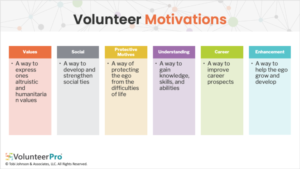3 Critical Variables to Consider for Your Volunteer Retention Strategy
In our Volunteer Management Progress Report survey, we’ve been able to track trends in volunteer retention strategies, and in years past it has been noted as a challenge for volunteer managers, not often the largest issue.
However, this past year we saw a major shakeup in the top challenges. Volunteer retention shot up to the second place, just after supervision. And recruitment, the top challenge for six previous years became less significant.
This is likely fueled by the desire to support existing volunteers versus new volunteers and by the reality that volunteers could not be engaged on-site due to COVID restrictions.
But there are real reasons to focus on keeping volunteers coming back. There’s plenty of uncertainty in our world today, so don’t no need to worry whether your volunteer retention strategy will work, too!
Read on for three critical variables that affect volunteer retention and how you can weave them into your volunteer retention strategy: volunteer motivation, the meaningfulness of work, and volunteer satisfaction.
Evidence-Based Volunteer Motivations
Volunteer motivations can be altruistic, meaning the volunteer has a desire to help others for the greater good, and/or instrumental, meaning they are volunteering to meet their own self-interests.
We talk a lot about volunteer motivations in our work because there is a body of evidence that validates their importance in every stage of the volunteer lifecycle.
This research shows that volunteers are driven by one, or more, of the following:
- Values – where the volunteer sees participation as an opportunity to meaningfully serve others
- Career – participant views the opportunity as facilitating advancement & networking in their industry or field of work
- Social – in which the participant receives a measure of acceptance & acknowledgment from peers
- Understanding – the volunteer gains knowledge or insight from the experience that would be hard to come by otherwise
- Protective Motives – being a participant ensures they’ll be in emotionally supportive settings
- Enhancement – volunteerism promotes leadership development and their perception of power
Also worthy of note, a volunteer’s motivations for initially volunteering may be different than their motivations to continue volunteering.
This will have implications on your volunteer recruitment strategy, so in order to boost your volunteer retention, it’s important that you continuously gauge motivation levels throughout the volunteer experience.
How do you do this? You can develop and conduct a questionnaire that’s designed to identify exactly where a volunteer’s motivations fall after 60 days of service.
Consider the following quick, 3 question survey:
1) Over the past 12 months, what has been your primary volunteer role? Choose the one the best applies to you. [list out your volunteer roles and list an option for “other” that they can fill in]
2) Please indicate how important or accurate each of the following is for you in doing volunteer work.
[1 – Not important at all, 2 – Of little importance, 3 – Somewhat important, 4 – Important, 5 – Very important, 6 – Absolutely essential]
-
- Volunteering helps me work through by own personal problems.
- Doing volunteer work relieves me of some of the guilt over being more fortunate than others.
- I feel it is important to help others.
- I can do something for a cause that is important to me.
- Volunteering experience will look good on my resume.
- I can make new contacts that might help my business or career.
- Volunteering is an important activity to the people I know best.
- My friends volunteer.
- Volunteering allows me to gain a new perspective on things.
- Volunteering lets me learn things through direct, hands-on experience.
- Volunteering is a way to make new friends.
- Volunteering makes me feel important
3) I intend to be volunteering with the Agency two years from now.
[1 – Strongly disagree, 2 – Disagree, 3 – Slightly disagree, 4 – Slightly agree, 5 – Agree, 6 – Agree strongly, Prefer Not to Say]
Once you receive responses, you will begin to see the primary volunteer motives at your agency. If you crosstab these with volunteer roles, you can develop an even deeper understanding of what drives volunteer satisfaction across departments and opportunities.
Then, you can develop a volunteer retention strategy that folds opportunities to meet those motives into every stage of the volunteer lifecycle. If volunteers believe that a volunteer opportunity and experience will satisfy their motives, they will be more likely to continue volunteering.
For more ideas on specific questions that give great insight on your volunteers, read our blog on The Importance of Volunteer Pulse Surveys.
You can also use some of the survey questions here to pinpoint the key motivations for your volunteer team.
Meaningfulness of the Work
When volunteers find meaning in their work, feel responsible for its outcomes, and are made aware of their impact and their results, they are more likely to stick around.
Research has shown that paid employees view their work in one of three ways: a job, a career, or a calling. This same idea can be applied to volunteer experiences as well.
This means you will need to tailor volunteer experiences that meet volunteers’ ongoing needs and motivations to feel their work has purpose is necessary. You can’t just place a volunteer in a file room, ask them to organize to their heart’s content, and assume their needs are being met. They need to know WHY and HOW their role is impacting the bigger picture.
There are a few ways you can accomplish this.
Job Crafting
In the study mentioned above, the researcher introduces a concept called “job crafting”, which in short means you can change your job to make it more meaningful.
There are three forms of job crafting you can weave into your volunteer retention strategy:
1) Task Crafting – altering the tasks that make up the position
2) Relational Crafting – altering whom you interact with on the job
3) Cognitive Crafting – alter how you interpret the work you are doing
So, how can you implement job crafting without your volunteers running wild?
Follow these tips below:
- Encourage volunteers to learn about additional, more meaningful responsibilities they can take on in addition to their current role. That filing volunteer I mentioned earlier? Perhaps they would love to end their shift by reading to children, taking a dog for a walk, or playing a quick game of cards with a patient.
- Allow your volunteers the opportunity to build relationships with volunteers and staff in other departments. Consider cross-departmental projects, tasks, or quarterly state of the volunteer program meetings to allow volunteers to start building those relationships.
- Praise your volunteers and their impact and encourage them to reflect on the meaning of their results. Sure, filing might not seem so glamorous or important of a job; however, when you and your colleagues reiterate how necessary it is to have this assistance so they can focus on providing much-needed services to clients, your volunteers will feel empowered.
Link Volunteer Motivations to Volunteer Performance and Outcomes
Is it possible to push volunteers for outcomes performance AND inspire them to keep coming back?
It’s a tough line to walk, holding volunteers, people who work without pay, accountable for their outcomes, and also giving them the encouragement they need to retain them.
However, it is possible!
Consider these practical approaches:
- Motivate your volunteers with some healthy competition! Create graphics that compare key performance metrics between teams or individuals. To be sensitive, leave out all team or individual identifying information, highlight the outcome for each team, and how they compare to others across the spectrum separately. Or, use a progress thermometer to track the global progress for one key outcome.
- Focus on an incremental change that promotes success early and often. Break annual targets into doable chunks and focus efforts on a few outcomes versus all of them. Celebrate improvement, even if there’s still a long way to go. Early success will help create a snowball effect.
- Recognize and reward individual contributions to progress. Share their stories via videos and agency newsletters and incorporate storytelling into recognition events. Be sure stories have a clearly described plotline, details on the challenge, and what was done to bring about change.
- Get people at all levels of the organization involved early in the development of a performance system. Create open forums where people can discuss their experiences and give each other tips. Also, reward success with increased participation. For example, recognize individuals for their hard work by inviting them to act in an advisory role in program development.
Show Your Volunteers They are Priceless with an Impact Portfolio
Similar to annual reports distributed by most nonprofits, an Impact Portfolio tells the story of your organization’s work on behalf of the community. In a more focused way, however, an Impact Portfolio can depict the impact of a single program or the volunteer services department. It can shed light on the collective experiences of clients, volunteers, staff, your community, your founders, and others who are affected by your work.
Here are a few things you might consider adding to your Impact Portfolio:
- A Calculation of Your Program’s Return on Investment (ROI) (keep scrolling for a freebie to help with this)
- Video Interviews that Share “Before and After” Stories
- A Visual Map Depicting Your Program’s Journey of Change
- Simple Graphics Showing Your Program’s Most Significant Outcomes
- Scanned Thank You Notes from Clients and Their Families
- News Articles That Cover Your Program’s Successes
- Photos From Your Most Recent Volunteer Recognition Event
- Links to Your Most Recent Grant Report or Outcomes Dashboard
Read more about creating an Impact Portfolio and where to share it in this blog post.
Volunteer Satisfaction
It should come as no surprise that the more satisfied your volunteers are in their role and their experience with your organization, the more likely they are to stay long-term.
Volunteer satisfaction is based on various factors including:
- Professional relationships with clients, other volunteers, and staff
- the quality of the work they are able to produce, and
- the use of the volunteer’s knowledge, skills, and abilities
Ensure you have measures in place to gauge satisfaction early on in the volunteer’s assignment and, if their satisfaction wanes, pivot their role and responsibilities to favorably impact their interest in staying on to complete their service.
Managing volunteer satisfaction early on in service is one sure-fire way you can improve retention rates.
There are a few ways you can accomplish this:
- Conduct a volunteer satisfaction survey. How will you really know how the majority of volunteers feel about their experience unless you ask?
- Facilitate conversations about volunteer needs. You can do this via one-on-one meetings, quarterly all-volunteer meetings, via social media or email, etc.
- Conduct exit surveys to find out why volunteers are leaving when they do. You can also find out how they might want to stay in touch with your organization. Do you have an alumni group they can join? Are they interested in donating? Are they available for episodic volunteer roles?
- Address toxic behaviors at work that might be scaring volunteers away. Be on the lookout for red flags such as leaders that misuse their power, personality clashes, bullying, internal politics.
- Promote your volunteers to leadership roles, as appropriate. Learn how to pinpoint volunteers who have leadership boots to fill, what mindsets limit volunteers from stepping up, and how to encourage volunteers to shine!
- Lastly, don’t overlook your own leadership development! Leadership training is very much an important part of your volunteer retention strategy. Consider looking for opportunities that will teach you how to demonstrate a variety of useful leadership practices to attract and retain people to your organization.
These are only a few things you might add to your volunteer retention strategy. Make sure you have identified your baseline retention numbers before you start making changes. How do volunteers rate their current experience? How many volunteers stay for one year? How many stay to the end of their projects? If you know where you are starting from, you’ll have a better idea about what’s working and where to focus your future efforts.










